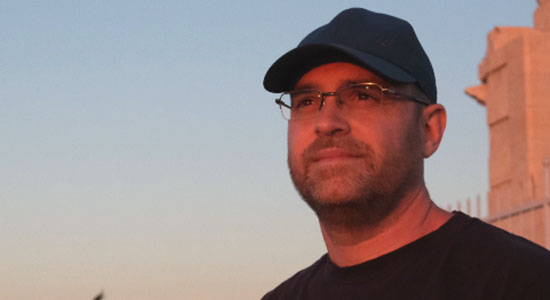Quantum Optoelectronic Devices
Our team explores cutting-edge integrated devices designed for generating and manipulating light at the nanoscale. These innovations aim to create photonic integrated devices that are smaller, faster, and more energy-efficient, applicable in both classical and quantum information processing.
The group established in 2022 at the Niels Bohr Institute, University of Copenhagen. We have a consolidated expertise in design, modelling, and fabrication of III/V optoelectronic devices, especially in the gallium arsenide (GaAs) material platform. With a broad background optoelectronics, we develop cutting-edge hardware for scalable photonic integrated circuits, including:
- Quantum dot devices for single-photon generation and quantum communication.
- Nanomechanical devices for on-chip programmable photonic devices.
- Hybrid and heterogeneous photonic systems for photonic integrated circuits.
- Nonlinear optoelectronic devices.
Nanoscale photonic devices have significantly advanced quantum photonics, enabling the development of sophisticated photonic integrated circuits. This progress has led to the miniaturization and integration of multiple photonic devices on a single chip, reducing costs and bridging the gap between laboratory demonstrations and real-world applications.
Quantum photonic integrated circuits (QPICs) offer unprecedented flexibility in routing and controlling light, eliminating the need for bulky optical components. Integrating light sources with multi-path interferometers and photon detectors into a unified platform could enhance the scalability of QPICs for application in quantum information processing.
By focusing on optically active materials, such as GaAs, with integrated quantum dot single-photon sources, new methods for switching and routing light can be developed, enhancing existing platforms for quantum photonics.
Nanomechanical quantum photonic integrated circuits
We explore the emerging technology of nano-opto electro-mechanical systems (NOEMS), where mechanical, optical, and electrical degrees of freedom are coupled [1].
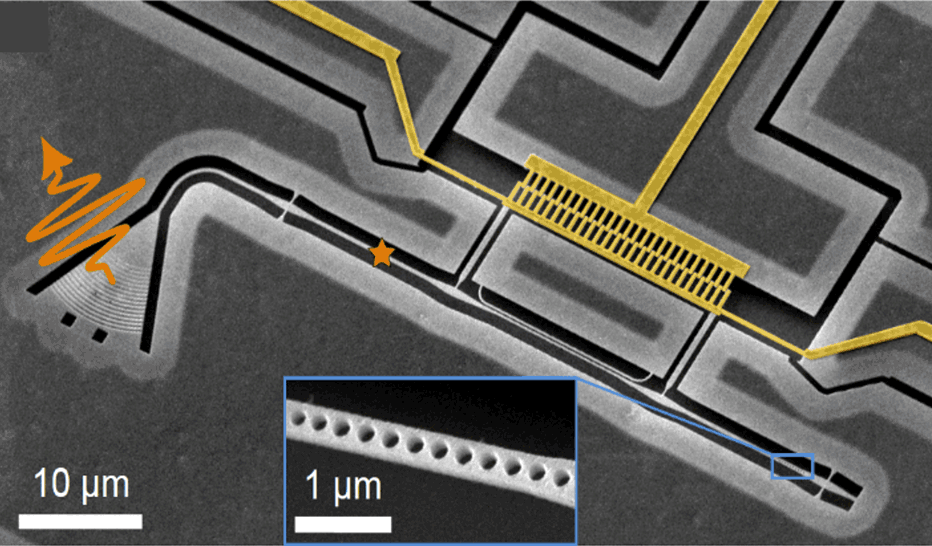
| arXiv:2503.01014) |
NOEMS devices, such as those with movable parts controlled by electrical forces, create effective electro-optic interactions by using mechanical movements to influence optical properties. An example includes a waveguide-integrated device for tuning the wavelength of a photonic crystal nanocavity through electrostatic forces [2].
Our research focuses on developing chip-scale, reconfigurable NOEMS devices like photon routers [3], wavelength-tuneable cavities, phase shifters [4], and filters [5], exploring their potential role in integrated quantum photonics.
Despite being an emerging technology with limited demonstrations, interest in NOEMS is rapidly growing, and their adoption in the quantum domain is expected within the next decade.
References
[1] L. Midolo, A. Schliesser, and A. Fiore “Nano-opto-electro-mechanical systems,” Nature Nanotechnology 13(1), 11—18 (2018).
[2] L. Midolo, P. J. van Veldhoven, M. A. Dündar, R. Nötzel, A. Fiore, “Electromechanical wavelength tuning of double-membrane photonic crystal cavities”, Applied Physics Letters, 98, 211120 (2011).
[3] C. Papon, X. Zhou, H. Thyrrestrup, Z. Liu, S. Stobbe, R. Schott, A. D. Wieck, A. Ludwig, P. Lodahl, and L. Midolo, “Nanomechanical single-photon routing,” Optica 6(4), 524—530 (2019).
[4] C. Qvotrup, R. Thomas, Z. Liu, M. Albrechtsen, A. Ludwig, A. D. Wieck, and L. Midolo, “Nanomechanical Phase Shifting on a Gallium Arsenide Platform,” in the 25th European Conference on Integrated Optics. ECIO 2024. Springer Proceedings in Physics, vol 402.
[5] X. Zhou, Z. Liu, C. Papon, R. Schott, A. D. Wieck, A. Ludwig, P. Lodahl, and L. Midolo, “On-chip nanomechanical filtering of quantum-dot single-photon sources,” Laser & Photonics Review 2020, 1900404 (2020).
Heterogeneous integration for quantum photonics
A big challenge in establishing scalable quantum photonics is to integrate light sources, routers, and detectors in a single circuit. Currently, no single material or platform offers the needed adaptability for quantum photonics (some materials are excellent at generating high-quality single photons, while others excel in low-loss or fast switching).
A promising solution is the heterogeneous integration of different materials into a common substrate.
In our team, we explore the integration of single-photon emitters based on quantum dots on various material platforms including GaAs-on-insulator, silicon, and silicon nitride. We investigate different integration processes, from wafer bonding to micro-transfer printing.
This research is done in a QuantERA collaboration with several partners including University of Ghent / IMEC (Belgium), University of Ljubljana (Slovenia), University of Heidelberg (Germany), and CSEM (Switzerland).
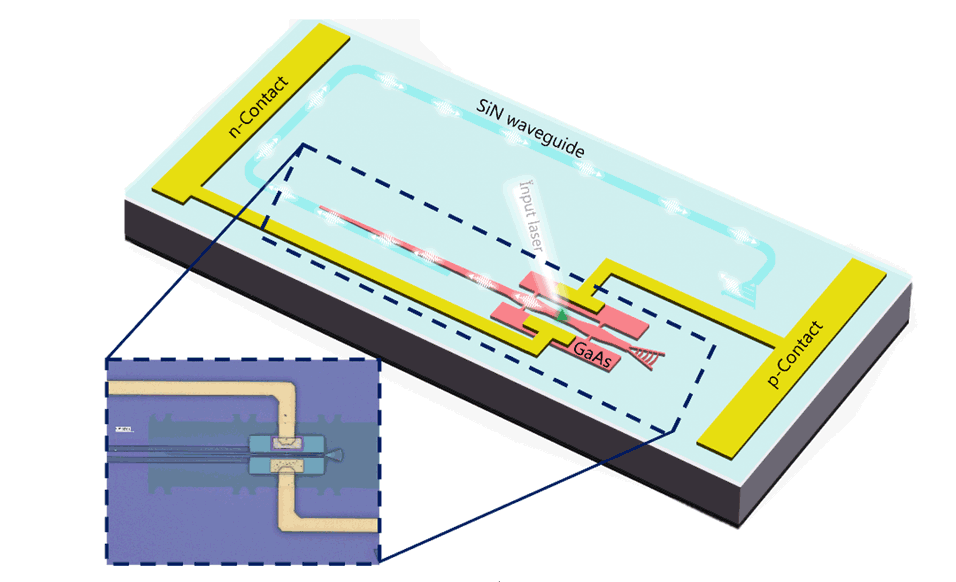
Quantum key distribution is a method for securely producing secret keys between two or more parties. Unlike the standard public-key cryptography, quantum cryptography does not rely on computational complexity to make the communication secure, but rather on the principles of quantum mechanics.
Single photons are excellent carrier of quantum information, which cannot be copied by an eavesdropper. We are developing QKD systems based on true single-photon sources from our quantum dot devices, either using frequency conversion schemes [1], or directly with emitters that produce photons in the O band (1270-1310 nm).
We test our QKD protocols on a dark fiber connecting NBI and DTU [2] and we are part of the Danish Quantum communication infrastructure (QCI.DK), building private and secure communication within the Danish government and health care system.
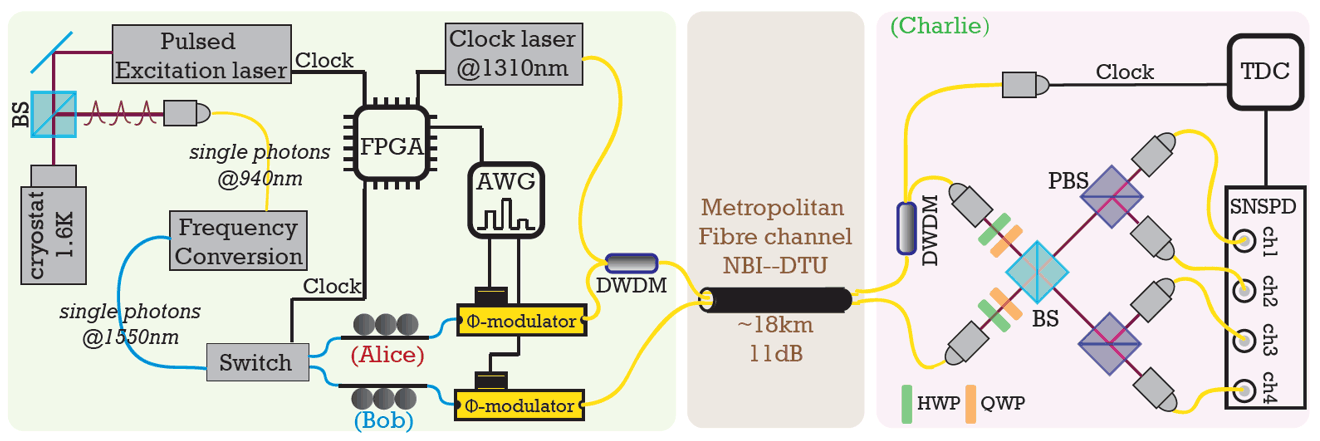
References:
[1] B. Da Lio, C. Faurby, X. Zhou, M. L. Chan, R. Uppu, H. Thyrrestrup, S. Scholz, A. D. Wieck, A. Ludwig, P. Lodahl, and L. Midolo, “A pure and indistinguishable single-photon source at telecommunication wavelength,” Advanced Quantum Technologies 202200006 (2022).
[2] M. Zahidy, M. T. Mikkelsen, R. Müller, B. Da Lio, M. Krehbiel, Y. Wang, N. Bart, A. D. Wieck, A. Ludwig, M. Galili, S. Forchhammer, P. Lodahl, L. K. Oxenløwe, D. Bacco, and L. Midolo, “Quantum Key Distribution using deterministic single-photon sources over a field-installed fibre link,” NPJ Quantum Information 10, 2 (2024).
Nanofabrication
We fabricate our optoelectronic devices in-house, at the Niels Bohr Institute cleanroom. We are specialized in III/V processing: etching, lithography, and deposition. Our group has developed software and process design kit (PDK) for GaAs photonic integrated circuits as well as the possibility to integrate our state-of-the-art chips with other materials including silicon photonics.
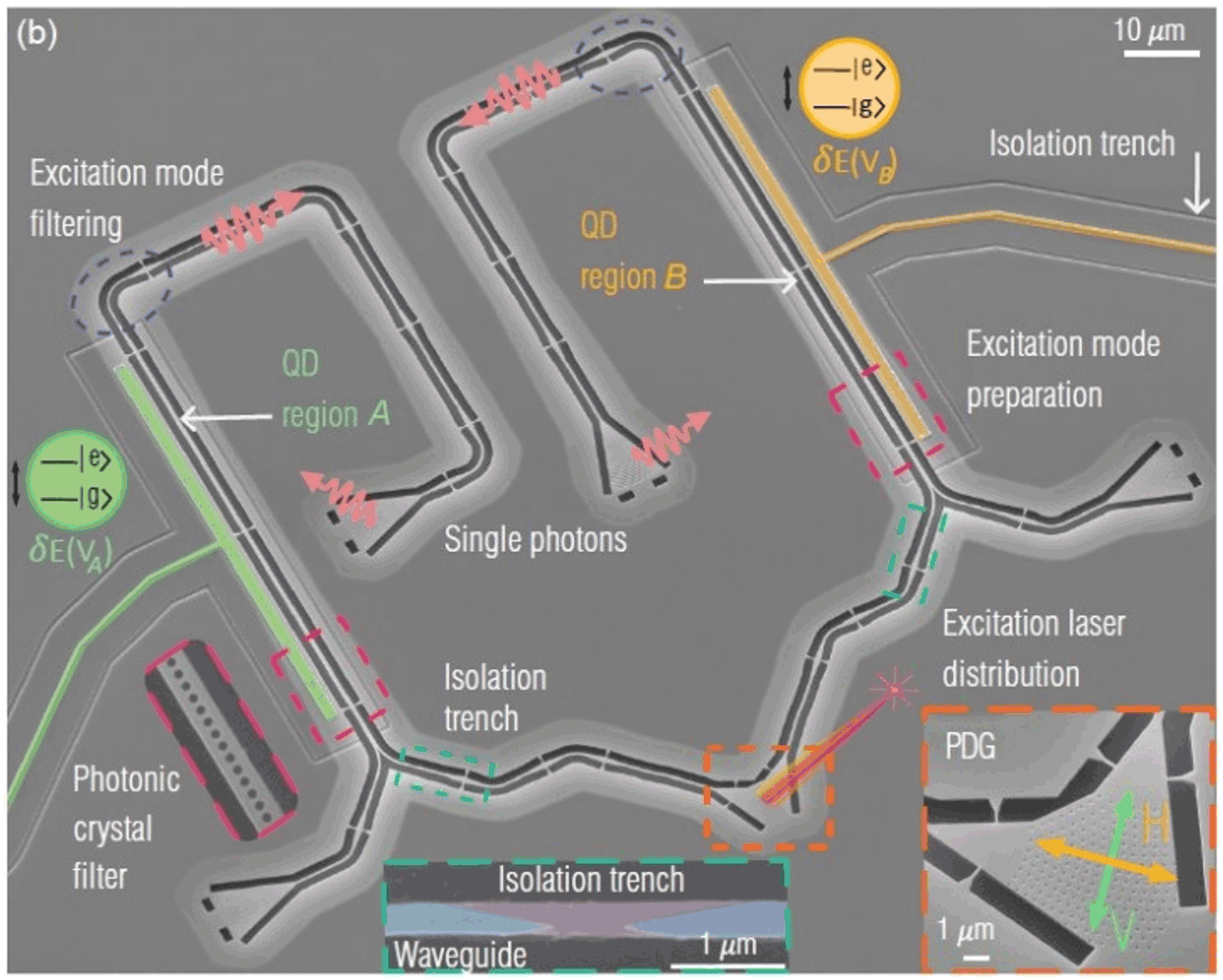
GaAs photonic integrated circuit with quantum emitters.
Optical characterization
Our optical laboratory is designed for photonic integrated devices and quantum emitters. We have two optical cryostats for the characterization of photonic integrated circuits at low temperatures and several instruments for optical and electrical measurements.
We have access to CW and pulsed lasers at 940 nm and 1300 nm, single-photon detectors, low-jitter time-taggers/electronics, high-speed electronics for modulation/encoding (for MEMS/QKD), and > 1M DKK worth of fiber and free-space optic setups.
BSc, MS, and internship projects: We frequently offer BSc and MSc projects, as well as project outside course scope (PUK). We are also happy to host international students for short internships (self-funded or via Erasmus+). Please refer to the “research project” section above, to get a general idea of the research areas we cover before reaching out. If you are interested, please send us a request, highlighting your interests and experience.
Teaching
Advanced Quantum Optics and Photonics.
This advanced MSc course covers the essentials of open quantum systems in photonics. See course content here. The course runs yearly from April to June. Enrolment from students outside KU is possible. You are welcome to reach out to get a copy of the course material.
Perspective article on Nano-opto-electromechanical systems.
SampleMaker: open-source Python package for photonic mask design.
Beamfox: proximity correction software, commercial. Spin out from NBI.
Publications and pre-prints from the group:
- C. Qvotrup, Y. Wang, M. Albrechtsen, R. A. Thomas, Z. Liu, S. Scholz, A. Ludwig, L. Midolo, "Controlling emitter-field coupling in waveguides with a nanomechanical phase shifter," arXiv:2503.01014 (2025).
- C. Qvotrup, Y. Wang, M. Albrechtsen, R. A. Thomas, Z. Liu, S. Scholz, A. Ludwig, L. Midolo, "Integration of a GaAs-based nanomechanical phase shifter with quantum-dot single-photon sources," arXiv:2503.01012 (2025).
- R. A. Thomas, C. Qvotrup, Z. Liu, and L. Midolo, “Noise performance of on-chip nano-mechanical switches for quantum photonics applications,” Advanced Quantum Technologies, 202400012 (2024).
- Qvotrup, Z. Liu, C. Papon, A. D. Wieck, A. Ludwig, and L. Midolo, “Curved GaAs cantilever waveguides for the vertical coupling to photonic integrated circuits,” Optics Express 32(3), 3723-3734 (2024).
- Zahidy, M. T. Mikkelsen, R. Müller, B. Da Lio, M. Krehbiel, Y. Wang, N. Bart, A. D. Wieck, A. Ludwig, M. Galili, S. Forchhammer, P. Lodahl, L. K. Oxenløwe, D. Bacco, and L. Midolo, “Quantum Key Distribution using deterministic single-photon sources over a field-installed fibre link,” NPJ Quantum Information 10, 2 (2024).
- Papon, Y. Wang, R. Uppu, S. Scholz, A.D. Wieck, A. Ludwig, P. Lodahl, and L. Midolo, “Independent operation of two waveguide-integrated quantum emitters,” Physical Review Applied 19, L061003 (2023).
- Shadmani, R. A. Thomas, Z. Liu, C. Papon, M. J. R. Heck, N. Volet, S. Scholz, A. D. Wieck, A. Ludwig, P. Lodahl, and L. Midolo, “Integration of GaAs waveguides on a silicon substrate for quantum photonic circuits,” Optics Express 30, 37595-37602 (2022).
- Da Lio, C. Faurby, X. Zhou, M. L. Chan, R. Uppu, H. Thyrrestrup, S. Scholz, A. D. Wieck, A. Ludwig, P. Lodahl, and L. Midolo, “A pure and indistinguishable single-photon source at telecommunication wavelength,” Advanced Quantum Technologies 202200006 (2022).
- Zhou, P. Lodahl, and L. Midolo, “In-plane resonant excitation of quantum dots in a dual-mode photonic-crystal waveguide with high β-factor,” Quantum Science and Technology 7, 025023 (2022).
- Wang, R. Uppu, X. Zhou, C. Papon, S. Scholz, A. D. Wieck, A. Ludwig, P. Lodahl, and L. Midolo, “Electroabsorption in gated GaAs nanophotonic waveguides,” Applied Physics Letters 118, 131106 (2021).
- Uppu, H. A. Eriksen, H. Thyrrestrup, A. D. Uğurlu, Y. Wang, S. Scholz, A. D. Wick, A. Ludwig, M. C. Löbl, R. J. Warburton, P. Lodahl, and L. Midolo, “On-chip deterministic operation of quantum dots in dual-mode waveguides for a plug-and-play single-photon source,” Nature Communications 11, 3782 (2020).
- Zhou, Z. Liu, C. Papon, R. Schott, A. D. Wieck, A. Ludwig, P. Lodahl, and L. Midolo, “On-chip nanomechanical filtering of quantum-dot single-photon sources,” Laser & Photonics Review 2020, 1900404 (2020).
- D. Uğurlu, H. Thyrrestrup, R. Uppu, C. Ouellet-Plamondon, R. Schott, A. D. Wieck, A. Ludwig, P. Lodahl, and L. Midolo, “Suspended spot-size converters for scalable single-photon devices,” Advanced Quantum Technologies 2, 1900076 (2019).
- Papon, X. Zhou, H. Thyrrestrup, Z. Liu, S. Stobbe, R. Schott, A. D. Wieck, A. Ludwig, P. Lodahl, and L. Midolo, “Nanomechanical single-photon routing,” Optica 6(4), 524—530 (2019).
- Zhou, I. Kulkova, T. Lund-Hansen, S. L. Hansen, P. Lodahl, and L. Midolo, “High-efficiency shallow-etched grating on GaAs membranes for quantum photonic applications,” Applied Physics Letters, 113, 251103 (2018).
- Midolo, A. Schliesser, and A. Fiore “Nano-opto-electro-mechanical systems,” Nature Nanotechnology 13(1), 11—18 (2018).
- Midolo, S. L. Hansen, W. Zhang, C. Papon, R. Schott, A. Ludwig, A. D. Wieck, P. Lodahl, and S. Stobbe “Electro-optic routing of photons from a single quantum dot in photonic integrated circuits,” Optics Express, 25(26), 33514—33526, (2017).
Celeste Qvotrup, PhD 2025, currently postdoc at DTU Health Tech
Rodrigo Thomas, Postdoc 2020-2024, currently at Novo Nordisk Quantum Computing Centre NQCP.
Camille Papon, PhD 2022, postdoc at MIT, currently at Microsoft
Asli Ugurlu, PhD 2021, currently at Quantum Machines
Leonardo Midolo, Associate professor
Niels Bohr Building,
Office: 02.3.G.074
Jagtvej 155, G-Tower 3rd floor
2200 København N.
Researchers
| Name | Title | |
|---|---|---|
| Search in Name | Search in Title | |
| Ali Ahmad | Research Assistant |
|
| Antonio Ortu | Research Consultant |
|
| Erik Antonius Petrus van Heijst | PhD Student |
|
| Hanna Krystyna Salamon | PhD Fellow |
|
| Leonardo Midolo | Associate Professor - Promotion Programme |
|
| Levin Maria Albert Seidt | PhD Fellow |
|
| Marcus Albrechtsen | International Researcher |
|
| Mikkel Thorbjørn Mikkelsen | PhD Fellow |
|
| Nikolaos Andrianopoulos | PhD Fellow |
|
| Ying Wang | Assistant Professor |
|

